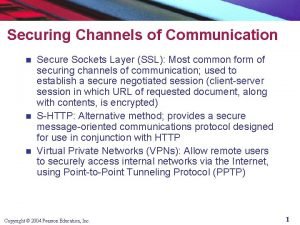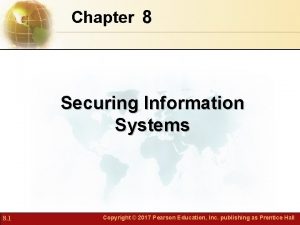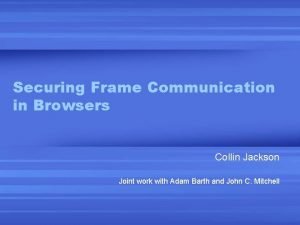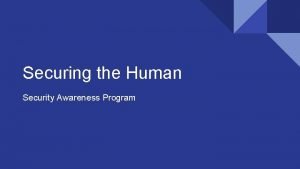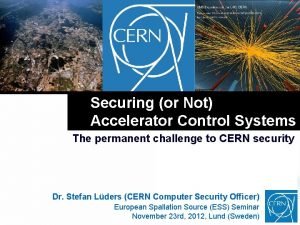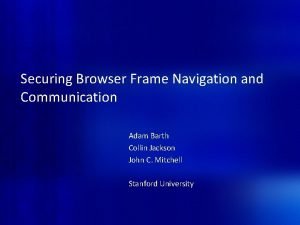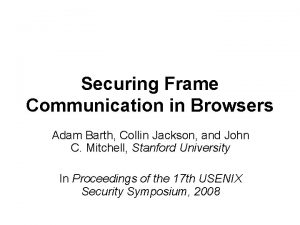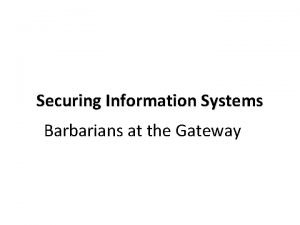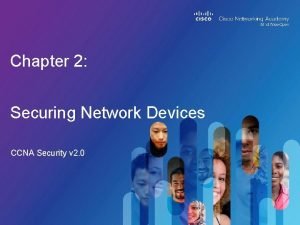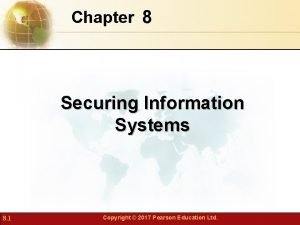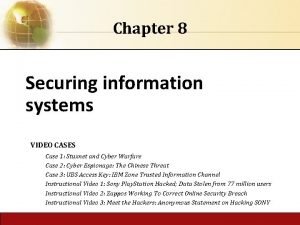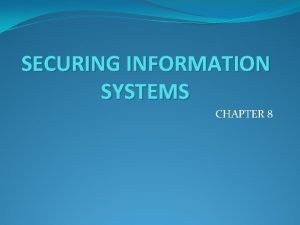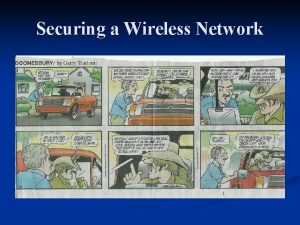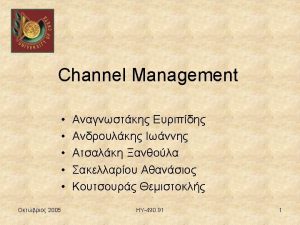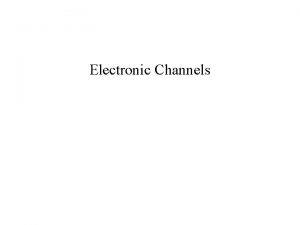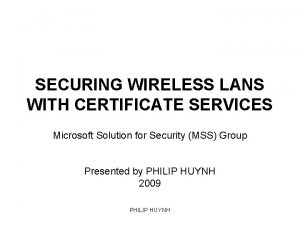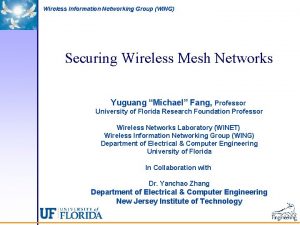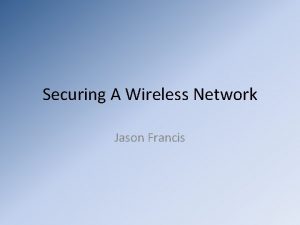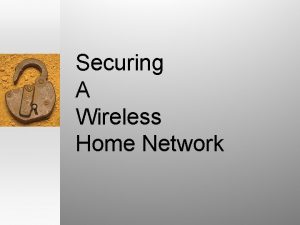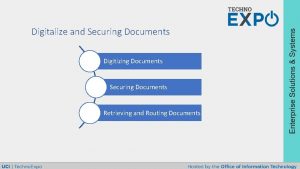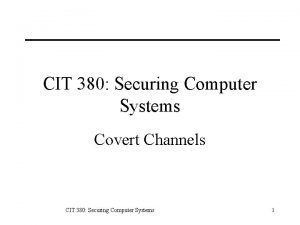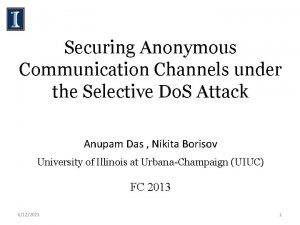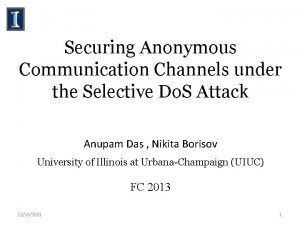Securing Wireless Channels Or the Case for Certificate






































- Slides: 38

Securing Wireless Channels (Or the Case for Certificate and Public Key Pinning)

What is OWASP? • The Open Web Application Security Project – Not just web anymore • Mission Driven – World wide, nonprofit, unbiased organization • Community Driven – 30, 000 Mail List Participants – 200 Active Chapters in 70 countries – 1600+ Members, 56 Corporate Supporters – 69 Academic Supporters

Around the World 200 Chapters, ~1600 Members, 30000+ Builders, Breakers and Defenders

About Me • Jeffrey Walton – Roles include • Mobile Security Architect • Senior Consultant • Security Engineer – Secure Coding Evangelist • Live and die by SDLCs

Agenda and Topics • Background – Architectures – Expectations • VPN/SSL/TLS Issues – Past Problems – Current Issues • Shared Secret – PSK – SRP • Pinning – Certificate – Public Key • Futures – Pinning (IETF) – Sovereign Keys – Convergence • Wrap Up – Questions

It’s All About the Data • Data is the only thing that matters – Who owns it – Who controls it – Who accesses it • Share data with appropriate parties – Must determine identity of parties • Can’t determine identity? – Don’t share data

Data Attributes • Data Sensitivity – Low • Public Information • Contact Information – Medium • Social Security Number • Bank Account • Single Sign On? – High • Pending Litigation, M&A • FERPA, HIPPA, GLBA, etc • Data States – Data at Rest • Server/Desktop/Device • Remote and Local – Data on Display • View/Read/Write/Edit • Local – Data in Transit • Secure Channel • Local ↔ Remote

Expectations • User Expectations? – End-to-end security • Web Applications – Padlocks tell me its secure – Green Bars tell me its secure – Marketing tells me its secure • How can {VPN|SSL|TLS} not be secure? – When did that happen?

Training (Conditioning? ) • • • Padlock looks secure Green bar looks secure $1, 500, 000 is a lot of money It looks secure It must be secure

Two Architectures • Two architectures in play – Employee ↔ Organization • VPN – Individual ↔ Service Provider • SSL/TLS • Security Boundaries – Sometimes Trust Zones – How many are traversed?

Architecture (Enterprise, VPN)

Architecture (Mobile, SSL/TLS)

Comes down to… • Infrastructure – Domain Name System (DNS) – Public Key Infrastructure (PKI{X}) – Certificate Authorities (CAs) • Employee ↔ Organization – Organization • Individual ↔ Service Provider – Individual, Provider


What’s Gone Wrong (1)? • Governments Want/Require Interception – Certified Lies: Detecting and Defeating Government Interception Attacks Against SSL, cryptome. org/ssl-mitm. pdf – http: //www. dailymail. co. uk/indiahome/indianews/article-2126277/No-secrets. Blackberry-Security-services-intercept-data-government-gets-way-messengerservice. html • Governments Engage in Interception – http: //www. thetechherald. com/articles/Tunisian-government-harvesting-usernamesand-passwords/12429/ • Vendors Provide Interception Taps – http: //www. cisco. com/web/about/security/intelligence/LI-3 GPP. html • Governments Use Interception Taps – https: //www. eff. org/nsa-spying • Mobile Interception is Patented – Lawful interception for targets in a proxy mobile internet protocol network, http: //www. google. com/patents/EP 2332309 A 1


What’s Gone Wrong (2)? • Handset manufactures add trusted roots – http: //gaurangkp. wordpress. com/tag/nokias-man-in-the-middle-attack/ • Carriers can add trusted roots – No reference yet, but http: //www. theregister. co. uk/2011/12/15/carrier_iq_privacy_latest/ • CAs can become compromised – http: //isc. sans. edu/diary. html? storyid=11500 • Researchers can create Rogue CAs – http: //www. win. tue. nl/hashclash/rogue-ca/ • DNS can become compromised – http: //forums. theregister. co. uk/forum/2/2011/09/05/dns_hijack_service_updated/ • Physical plant can become compromised – http: //www. pcworld. com/article/119851/paris_hilton_victim_of_tmobiles_web_flaws. html • Its easy to set up an AP or Base Station (Chris Paget's IMSI Catcher) – http: //www. wired. com/threatlevel/2010/07/intercepting-cell-phone-calls/


What’s Gone Wrong (3)? • Can't trust some CAs – they will sell you out and issue subordinate CAs for money – http: //www. net-security. org/secworld. php? id=12369 – http: //www. zdnet. com/trustwave-sold-root-certificate-for-surveillance-3040095011/ • Can't trust some browsers – they will sell you out and elide their responsibility – https: //bugzilla. mozilla. org/show_bug. cgi? id=724929 • Can't trust some browsers – they include questionable certificates out of the box – https: //bugzilla. mozilla. org/show_bug. cgi? id=542689 • Can't override some browser's CA list – http: //my. opera. com/community/forums/topic. dml? id=1580452 • Can't override OS's CA list – http: //support. google. com/android/bin/answer. py? hl=en&answer=1649774 • CRL/OCSP does not work as expected/intended – http: //blog. spiderlabs. com/2011/04/certificate-revocation-behavior-in-modernbrowsers. html – https: //blog. torproject. org/blog/detecting-certificate-authority-compromises-and-webbrowser-collusion


What’s Gone Wrong (4)? • User will break it too (not just bad guys) – http: //www. esecurityplanet. com/mobile-security/hacker-bypasses-apples-ios-in-apppurchases. html – http: //www. h-online. com/security/news/item/Apps-for-Windows-8 -easily-hacked 1767839. html • Interception proxies additional risk – http: //blog. cryptographyengineering. com/2012/03/how-do-interception-proxiesfail. html • HTTPS is broken – http: //www. thoughtcrime. org/software/sslstrip/ • PKI is broken – www. cs. auckland. ac. nz/~pgut 001/pubs/pkitutorial. pdf • The Internet is Broken : ) – http: //blog. cryptographyengineering. com/2012/02/how-to-fix-internet. html

Decisions, Decisions…


Remediation • Stop Conferring Trust! • Cut-out the middle men • Harden the Channel! • Leverage the pre-existing relationship • Verify the Host • Password Authenticated Key Exchange – Shared secret • Public Key Cryptography – Public/Private key pair


Secure Remote Password (SRP) • Secure Remote Password (SRP) – Thomas Wu, RFC 5054 • User knows the password – Client hashes before use • Server knows the verifier – Similar to Unix passwd file • Diffie-Hellman based – Discrete logs (hard problem) – gab → g{(salt + password)|verifier} + nonces

Pre Shared Key (PSK) • Pre Shared Key (PSK) – RFC 4279 • Three Flavors – PSK Key Exchange • Secret used as Premaster Secret, use only symmetric key algorithms – DHE_PSK Key Exchange • PSK authenticates Diffie-Hellman exchange – RSA_PSK Key Exchange • combines public-key-based server authentication with mutual authentication using a PSK


Public Key Cryptography • All we need is a signing key for identity… – RSA, DSA, ECDSA • … and an ephemeral exchange – DHE, ECDHE, MQV, HMQV, FHMQV, etc • SSH got it right – Strict. Host. Key. Checking option @@@@@@@@@@@@@@@@@@@@@@@@@@@@@@ @ WARNING: REMOTE HOST IDENTIFICATION HAS CHANGED! @ @@@@@@@@@@@@@@@@@@@@@@@@@@@@@@ IT IS POSSIBLE THAT SOMEONE IS DOING SOMETHING NASTY! Someone could be eavesdropping on you right now (man-in-the-middle attack)! It is also possible that the RSA host key has just been changed.

General Idea • Whitelist expected Certificates or Public keys – There’s a pre-existing relationship – Or, make a note during first connect – Side step the “key distribution” problem • Certificate or Public Key Pinning – Libraries offer ‘On. Connect’ callback – In the callback, inspect certificate or public key

Bad Cases • Good case – Server is identified by expected cert or key • Bad case – Adversary is using a different public key • Not expected, so fail – Adversary is advertising expected public key • Can’t decrypt communications • Really Bad Case – Adversary is using expected public key • Can decrypt communications – pwn’d

Certificate or Public Key? • X 509 Certificate – Binds public key to entity – Version 3 information – Certificate may be rotated • Public Key – Must be static, cannot change – May violate some key rotation policies – Does not depend on certificate

Sample Code • Sample Code – Windows/. Net – Android/Java – i. OS/Objective C – Open. SSL/C


Futures • Public Key Pinning Extension for HTTP – draft-ietf-websec-key-pinning-04 – http: //www. ietf. org/id/draft-ietf-websec-key-pinning 04. txt • Sovereign Keys Project – http: //www. eff. org/sovereign-keys – DNSSEC to distribute certificates and keys • Convergence – http: //convergence. io – Redundant view of sites and certificates/keys

Does It Work?

Wrap Up • Data is all that matters – Identify parties, then share data • PSK, SRP and Pinning – Does not confer trust – Don’t care about answers from DNS or CAs – Leverages pre-existing relationship • Sovereign Keys and Convergence – Does confer trust – Still getting answers from others – Useful if no pre-existing relationship

Wrap Up • Questions? – Hopefully useful Answers • Jeffrey Walton – jeffrey. waltοn@softwareintegrity. cοm
 The most common form of securing channel is through
The most common form of securing channel is through Telecommunications, the internet, and wireless technology
Telecommunications, the internet, and wireless technology Best case worst case average case
Best case worst case average case Chapter 8 securing information systems
Chapter 8 securing information systems Securing information systems
Securing information systems Securing the northwest territory
Securing the northwest territory Securing frame communication in browsers
Securing frame communication in browsers Securingthehuman
Securingthehuman Securing
Securing Securing windows 7
Securing windows 7 Chapter 8 securing information systems
Chapter 8 securing information systems Adam secure browser
Adam secure browser Securing frame communication in browsers
Securing frame communication in browsers Securing information systems
Securing information systems Securing windows 7
Securing windows 7 Securing network devices
Securing network devices Chapter 8 securing information systems
Chapter 8 securing information systems Chapter 8 securing the republic summary
Chapter 8 securing the republic summary Securing information systems
Securing information systems Client draping
Client draping Securing information systems summary
Securing information systems summary Claes martinsson
Claes martinsson Tillitsbaserad ledning
Tillitsbaserad ledning Vem räknas som jude
Vem räknas som jude Ro i rom pax
Ro i rom pax Bra rim texter
Bra rim texter Nyckelkompetenser för livslångt lärande
Nyckelkompetenser för livslångt lärande Mästare lärling modell
Mästare lärling modell Varför kallas perioden 1918-1939 för mellankrigstiden?
Varför kallas perioden 1918-1939 för mellankrigstiden? Borstål, egenskaper
Borstål, egenskaper Shivaismen
Shivaismen Bamse för de yngsta
Bamse för de yngsta Verktyg för automatisering av utbetalningar
Verktyg för automatisering av utbetalningar Expektans
Expektans Jag har gått inunder stjärnor text
Jag har gått inunder stjärnor text Sura för anatom
Sura för anatom Boverket ka
Boverket ka Strategi för svensk viltförvaltning
Strategi för svensk viltförvaltning Novell typiska drag
Novell typiska drag
